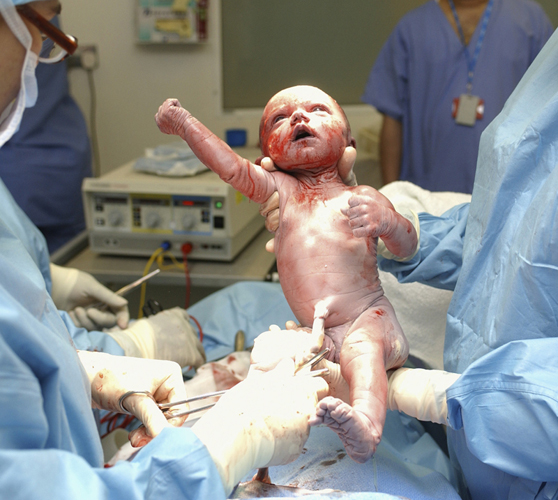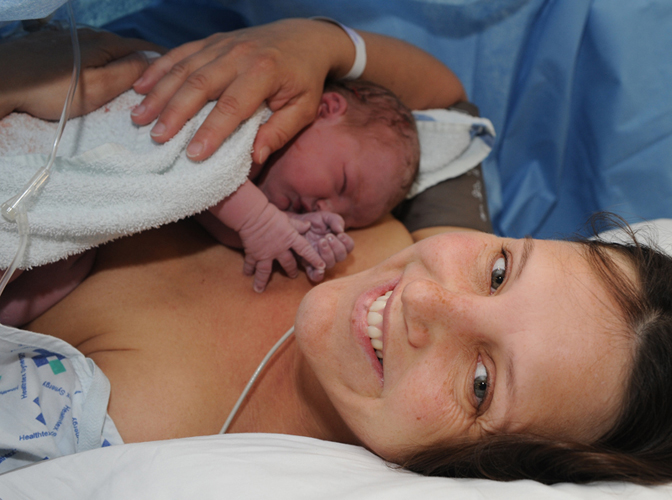The three stages of labor How your labor progresses
Your labor is divided
into three stages. The first stage begins when you have regular
contractions that open your cervix; the second stage starts when your
cervix is fully dilated and ends with the birth of your baby; and the
third stage is the delivery of the placenta and membranes.
| Q: |
What is the first stage of labor?
|
| A: |
The first stage of labor describes the process in which your
cervix dilates (progressively opens because of the uterus contracting)
from being tightly closed to being around 10 cm—wide enough to get the
baby out, or “fully dilated.” During this first stage of labor,
contractions generally start off gently and don't last very long—about
30–45 seconds. It is now recognized that you are in established labor
only if you are 4 cm dilated. Prior to this stage, the contractions you
have been feeling have been ripening (effacing) your cervix. During the
early stages of labor, it is a good idea to rest and eat carbohydrates
such as toast or soup, so that you will have some energy when the
contractions really kick in. This is called the latent stage of labor.
Once the contractions do start coming regularly, staying active is
beneficial in that it can help labor become established, as gravity will
help press your baby against your cervix. Going to bed could result in
labor ceasing altogether. In a first labor, the time from the start of
established labor to full dilation is between 6 and 12 hours, although
it is often quicker for subsequent labors.
|
| Q: |
What is “transition”?
|
| A: |
Toward the end of the first stage of labor, you may feel a great
urge to push with each contraction. This period, when you are between
8–10 cm dilated, is called transition. It may be brief, or could last up
to an hour, and is often seen as the most challenging part of labor.
You will need to resist the urge to push if you are not fully dilated,
and may need to use breathing techniques—such as blowing out in little
puffs—to help you.
|
| Q: |
What is the second stage of labor?
|
| A: |
Once your cervix is fully opened (fully dilated), this is known
as the second stage of labor. At the beginning of the second stage, you
may experience a pause in contractions, but they will resume and you
will be ready to push your baby out with each contraction. Your
contractions will now be very close together and very strong, lasting
60–90 seconds, but now you can have some control and assist your own
progress. Most hospitals will limit the length of the pushing stage to
less than three hours. You will soon see your baby.
|
| Q: |
What is the third stage of labor?
|
| A: |
The third stage of labor is the delivery of your placenta. This
is the afterbirth that has been feeding your baby during pregnancy. When
the placenta presents at the cervix, you may be asked to push to
release the placenta as your doctor or midwife carefully extracts it. An
injection into your IV, leg, or arm of oxytocin is often given after
expulsion of the placenta. This minimizes blood loss by helping the
uterus to contract.
|
The birth of your baby
1. Early labor:
In the early stages of
labor before contractions have become established, try to spend time
relaxing to conserve your energy for the hours to come. Drinking fluids
and eating a light snack is also advised in early labor.

2. Pushing down:
In the second stage of
labor, once your contractions are regular and have increased in
strength, you will be encouraged to actively push with each contraction
to help your baby move down in the pelvis.

3. Crowning of the head:
As the head crowns, your midwife will tell you to stop pushing and to pant instead so that the head is delivered gradually.
4. Your baby is born:
The midwife or
doctor delivers your baby, who arrives as a red and slippery bundle,
covered in blood, waxy vernix, and amniotic fluid.

5. Cutting the cord:
The umbilical cord is clamped in two places and the midwife, or perhaps your partner, cuts the cord between the two clamps.

6. Welcoming your baby:
Letting go and enjoying close contact with your baby after the birth is a precious time.

Myths and misconceptions Is it true that…
| Q: |
If you exercise a lot, your strong stomach muscles make it harder to push the baby out?
|
| A: |
Afraid not! The more fit you are, the easier it is to give birth.
For a start, you can actually support your own body so you can squat
and get into good birth positions. There are other advantages, too: fit
women tend to have shorter labors and get their figures back more
quickly.
|
| Q: |
You'll swear at your partner and everyone else when giving birth?
|
| A: |
Not strictly true—although no one will blame you if you do!
Giving birth can be incredibly painful, and you may feel emotional,
irritable, shaky, and even nauseous. Don't worry too much about what you
say and do: remember, the pain signals that labor is progressing, and
your baby will be born soon.
|
| Q: |
You need a super-high pain tolerance?
|
| A: |
Nobody likes pain, and it is often said that giving birth is almost unbearably painful.
However, your body's endorphin levels will increase during labor to
cope with the pain. So, as the intensity of the contractions build, so
does your ability to handle them.
|